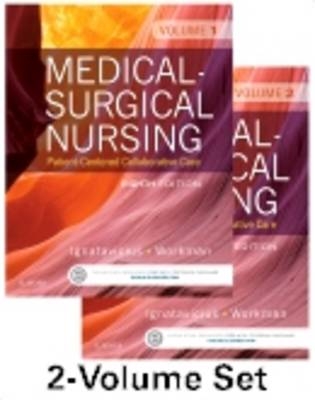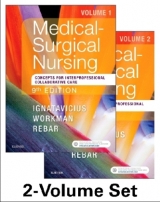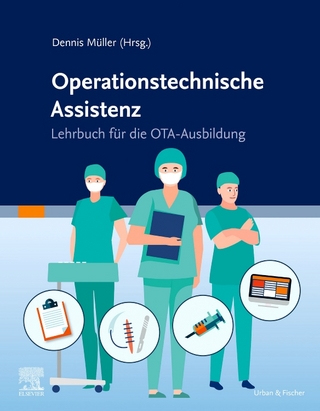
Medical-Surgical Nursing
Saunders (Verlag)
978-1-4557-7258-2 (ISBN)
- Titel erscheint in neuer Auflage
- Artikel merken
UNIQUE! Collaborative care approach organizes all medical, surgical, nursing, and other interventions within the framework of the nursing process, mirroring the nurse's role in the coordination/management of care in the real world of medical-surgical nursing.
Easy to read, direct-address writing style makes this one of the most readable medical-surgical nursing textbooks available.
UNIQUE! A focus on QSEN emphasizes patient safety and evidence-based practice with Nursing Safety Priority boxes including Drug Alerts, Critical Rescues, and Action Alerts.
UNIQUE! Emphasis on clinical judgment teaches you to develop skills in clinical reasoning and clinical decision-making when applying concepts to clinical situations, with Clinical Judgment Challenge questions throughout the chapters.
An emphasis on prioritization stresses the most important patient problems and nursing interventions, with patient problems presented in a single prioritized list of nursing diagnoses and collaborative problems.
UNIQUE! NCLEX preparation tools include chapter-opening Learning Outcomes and chapter-ending Get Ready for the NCLEX Examination! sections organized by NCLEX� Client Needs Categories, plus NCLEX Examination Challenge questions, with an answer key in the back of the book and on the Evolve companion website.
UNIQUE! A focus on nursing concepts relates concepts learned in Nursing Fundamentals with the disorders you will study in Medical-Surgical Nursing.
Practical learning aids include NCLEX Examination Challenges, Clinical Judgment Challenges, Best Practice for Patient Safety & Quality Care charts, common examples of drug therapy, concept maps, laboratory profiles, and more.
A clear alignment with the language of clinical practice reflects the real world of nursing practice with NANDA diagnostic labels where they make sense, and non-NANDA diagnostic labels when these are more common descriptions of patient problems.
Student Resources on an Evolve companion website help you prepare for class, clinicals, or lab with video and audio clips, animations, case studies, a concept map creator, NCLEX exam-style review questions, and more.�
UNIQUE! Concentration on essential knowledge for the RN level of medical-surgical nursing practice focuses your attention on need-to-know content to pass the NCLEX Examination and practice safety as a beginning nurse.
NEW! Enhanced focus on QSEN (Quality and Safety Education for Nurses) competencies includes new icons identifying QSEN competency material and new Quality Improvement boxes describing projects that made a dramatic difference in patient outcomes.
UPDATED learning features include an expanded emphasis on developing clinical judgment skills; on prioritization, delegation, and supervision skills; on long-term care issues; and on preparation for the NCLEX� Examination and consistency with the 2013 NCLEX-RN� Test Plan.
NEW! UNIQUE! Care of Transgender Patients chapter discusses the unique health care needs and issues specific to the transgender community.
Improved delineation of NANDA-I nursing diagnoses clearly differentiate NANDA diagnoses from collaborative problems.
NEW photos and drawings show patient care skills as well as the latest in nursing education and practice.
Unit 1: Foundations for Medical-Surgical Nursing
1. Introduction to Medical-Surgical Nursing Practice
2. Common Health Problems of Older Adults
3. Assessment and Care of Patients with Pain
4. Genetic Concepts for Medical-Surgical Nursing
5. Evidence-Based Practice in Health Care
6. Rehabilitation Concepts for Chronic and Disabling Health Problems
7. End-of-Life Care
Unit II: Concepts of Emergency Care and Disaster Preparedness
8. Concepts of Emergency and Trauma Nursing
9. Care of Patients with Common Environmental Emergencies
10. Concepts of Emergency and Disaster Preparedness
Unit III: Management of Patients with Fluid, Electrolyte, and Acid-Base Imbalances
11. Assessment and Care of Patients with Fluid and Electrolyte Imbalances
12. Assessment and Care of Patients with Acid-Base Imbalances
13. Infusion Therapy
Unit IV: Management of Perioperative Patients
14. Care of Preoperative Patients
15. Care of Intraoperative Patients
16. Care of Postoperative Patients
Concept Overview: Protection
Unit V: Problems of Protection: Management of Patients with Problems of the Immune System
17. Inflammation and the Immune Response
18. Care of Patients with Arthritis and Other Connective Tissue Diseases
19. Care of Patients with HIV Disease and Other Immunodeficiencies
20. Care of Patients with Immune Function Excess: Hypersensitivity (Allergy) and Autoimmunity
21. Cancer Development
22. Care of Patients with Cancer
23. Care of Patients with Infection
Unit VI: Problems of Protection: Management of Patients with Problems of the Skin, Hair, and Nails
24. Assessment of the Skin, Hair, and Nails
25. Care of Patients with Skin Problems
26. Care of Patients with Burns
Concept Overview: Oxygenation and Tissue Perfusion
Unit VII: Problems of Oxygenation: Management of Patients with Problems of the Respiratory Tract
27. Assessment of the Respiratory System
28. Care of Patients Requiring Oxygen Therapy or Tracheostomy
29. Care of Patients with Noninfectious Upper Respiratory Problems
30. Care of Patients with Noninfectious Lower Respiratory Problems
31. Care of Patients with Infectious Respiratory Problems
32. Care of Critically Ill Patients with Respiratory Problems
Unit VIII: Problems of Cardiac Output and Tissue Perfusion: Management of Patients with Problems of the Cardiovascular System
33. Assessment of the Cardiovascular System
34. Care of Patients with Dysrhythmias
35. Care of Patients with Cardiac Problems
36. Care of Patients with Vascular Problems
37. Care of Patients with Shock
38. Care of Patients with Acute Coronary Syndromes
Unit IX: Problems of Tissue Perfusion: Management of Patients with Problems of the Hematologic System
39. Assessment of the Hematologic System
40. Care of Patients with Hematologic Problems
Concept Overview: Mobility, Sensory Perception, and Cognition
Unit X: Problems of Cognition, Mobility, and Sensory Perception: Management of Patients with Problems of the Nervous System
41. Assessment of the Nervous System
42. Care of Patients with Problems of the Central Nervous System: The Brain
43. Care of Patients with Problems of the Central Nervous System: The Spinal Cord
44. Care of Patients with Problems of the Peripheral Nervous System
45. Care of Critically Ill Patients with Neurologic Problems
Unit XI: Problems of Sensation: Management of Patients with Problems of the Sensory System
46. Assessment of the Eye and Vision
47. Care of Patients with Eye and Vision Problems
48. Assessment and Care of Patients with Ear and Hearing Problems
Unit XII: Problems of Mobility: Management of Patients with Problems of the Musculoskeletal System
49. Assessment of the Musculoskeletal System
50. Care of Patients with Musculoskeletal Problems
51. Care of Patients with Musculoskeletal Trauma
Concept Overview: Nutrition, Metabolism, and Bowel Elimination
Unit XIII:� Problems of Digestion, Nutrition, and Elimination: Management of Patients with Problems of the Gastrointestinal System
52. Assessment of the Gastrointestinal System
53. Care of Patients with Oral Cavity Problems
54. Care of Patients with Esophageal Problems
55. Care of Patients with Stomach Disorders
56. Care of Patients with Noninflammatory Intestinal Disorders
57. Care of Patients with Inflammatory Intestinal Disorders
58. Care of Patients with Liver Problems
59. Care of Patients with Problems of the Biliary System and Pancreas
60. Care of Patients with Malnutrition and Obesity
Unit XIV: Problems of Regulation and Metabolism: Management of Patients with Problems of the Endocrine System
61. Assessment of the Endocrine System
62. Care of Patients with Pituitary and Adrenal Gland Problems
63. Care of Patients with Problems of the Thyroid and Parathyroid Glands
64. Care of Patients with Diabetes Mellitus
Concept Overview: Urinary Elimination
Unit XV: Problems of Excretion: Management of Patients with Problems of the Renal/Urinary System
65. Assessment of the Renal/Urinary System
66. Care of Patients with Urinary Problems
67. Care of Patients with Kidney Disorders
68. Care of Patients with Acute Kidney Injury and Chronic Kidney Disease
Unit XVI: Problems of Reproduction: Management of Patients with Problems of the Reproductive System
69. Assessment of the Reproductive System
70. Care of Patients with Breast Disorders
71. Care of Patients with Gynecologic Problems
72. Care of Patients with Male Reproductive Problems
73. Care of Transgender Patients
74. Care of Patients with Sexually Transmitted Disease
Glossary
| Verlagsort | Philadelphia |
|---|---|
| Sprache | englisch |
| Maße | 222 x 281 mm |
| Themenwelt | Pflege ► Fachpflege ► Chirurgie / OP-Pflege / Orthopädie |
| ISBN-10 | 1-4557-7258-5 / 1455772585 |
| ISBN-13 | 978-1-4557-7258-2 / 9781455772582 |
| Zustand | Neuware |
| Haben Sie eine Frage zum Produkt? |
aus dem Bereich



